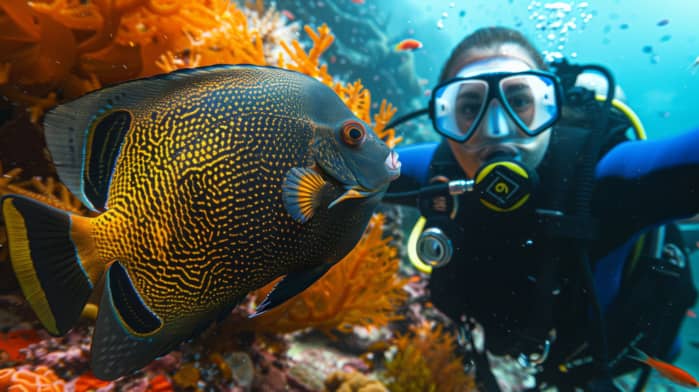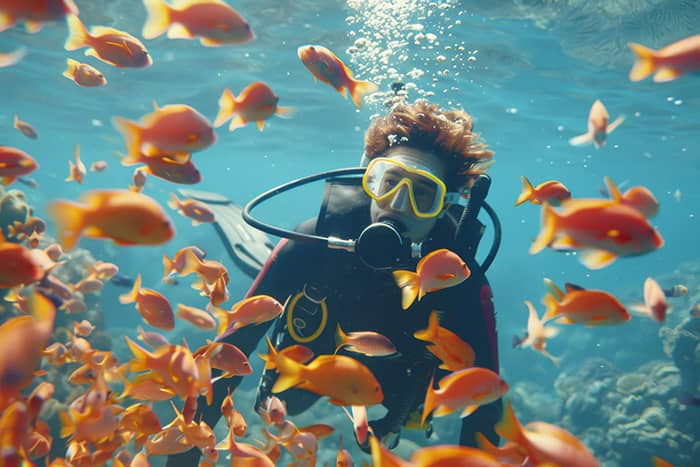Goa, with its sun-kissed beaches and pulsating nightlife, is a haven for travelers seeking sun, sand, and adventure. But beyond the shoreline lies a hidden gem—an underwater paradise teeming with marine life and mesmerizing dive sites. Scuba diving in Goa is an exhilarating way to explore this coastal state’s lesser-known wonders, offering something for everyone, from first-timers to seasoned divers. Whether you’re curious about shipwrecks, coral reefs, or the vibrant aquatic world, this guide has everything you need to know to dive into Goa’s underwater realm.
Why Scuba Dive in Goa?
Goa’s location along the Arabian Sea blesses it with warm waters, diverse marine ecosystems, and accessible dive sites. Unlike some global diving hotspots that require advanced skills, Goa caters to all levels. Beginners can dip their toes (and fins) in shallow, calm waters, while experienced divers can venture deeper to explore wrecks and reefs. With professional dive centers dotting the coast, scuba diving here is both safe and thrilling.
When to Dive: The Best Time
Timing is key for an unforgettable scuba diving experience. The optimal season runs from October to May, when the weather is dry, and the sea is calm. Water visibility during these months can reach up to 20 meters, offering crystal-clear views of the underwater world. Summer months (March to May) can get warm, but the diving remains excellent. Avoid the monsoon season (June to September), as rough seas, strong currents, and murky waters make diving unsafe and unenjoyable.
Top Dive Sites in Goa
Goa’s dive sites are as varied as its beaches. Here are the must-visit spots:
Grande Island
A hotspot for divers, Grande Island is famed for its shipwrecks, including the SS Rita and Davy Jones Locker. These sunken vessels, now artificial reefs, attract schools of fish and curious marine creatures. The shallow waters here (5-15 meters) are perfect for beginners, while deeper sections challenge advanced divers.
Netrani Island
Located about 100 km from Goa near Karnataka, Netrani is worth the trip for its pristine coral reefs and abundant marine life. The water’s clarity and biodiversity—think parrotfish, turtles, and barracudas—make it a favorite among seasoned divers.
Pigeon Island
For an adrenaline rush, Pigeon Island offers underwater caves and rocky formations. Depths range from 10 to 25 meters, ideal for advanced divers seeking adventure. Schools of jacks and occasional reef sharks add to the thrill.
Additional Spots
- Sail Rock: Known for its dramatic underwater cliffs.
- Devagh Island: A quieter site with gentle currents and colorful corals.
Each location offers a unique dive, blending natural beauty with historical intrigue.
Suggested Read- Why You Should Take a 6-Day Solo Trip to Andaman
What You’ll See: Marine Life in Goa
Goa’s underwater world is a kaleidoscope of colors and creatures. Expect to encounter:
- Reef Fish: Vibrant species like parrotfish, angelfish, clownfish, and butterflyfish dart among the corals.
- Larger Marine Life: Spot sea turtles, moray eels, rays, and even barracudas.
- Rare Sightings: Lucky divers might glimpse reef sharks or playful dolphins.
- Corals: Hard and soft corals create stunning underwater gardens, especially around Netrani.
The diversity ensures every dive feels like a new discovery.
Safety First: Tips and Precautions
Scuba diving is safe with the right precautions. Here’s how to stay secure:
- Dive with a Certified Instructor: Essential for beginners and recommended for all.
- Check Weather Conditions: Avoid diving in storms or high winds.
- Inspect Equipment: Ensure masks, regulators, and tanks are in top shape—most dive centers handle this, but double-check.
- Know Your Limits: Stick to dives matching your skill level and never dive solo.
- Stay Hydrated: Dehydration can increase risks underwater.
Reputable dive centers prioritize safety, so choose wisely.
How Much Does It Cost?
Scuba diving in Goa is reasonably priced, with options for every budget:
- Discovery Dive: INR 3,000–5,000. A guided shallow dive for beginners, including gear and instruction.
- Certified Diver Dives: INR 4,000–7,000 for deeper or specialty dives.
- Packages: Multi-dive deals or group discounts can lower costs.
- Certification Courses: The PADI Open Water Diver course ranges from INR 15,000–20,000.
Prices vary by season and operator, so shop around for deals, especially during off-peak months like October or April.

Getting Certified in Goa
Want to take your diving to the next level? Goa’s dive schools offer globally recognized certifications, primarily through PADI:
- Open Water Diver: The beginner course (3-4 days, INR 15,000–20,000) covers theory, confined water practice, and open water dives.
- Advanced Open Water: Enhances skills with deeper dives and navigation (2-3 days, INR 12,000–18,000).
- Specialty Courses: Options like wreck diving or underwater photography are available.
Certification opens doors to dive sites worldwide, and Goa’s warm waters make it an ideal learning ground.
Suggested Read- Top River Rafting Destinations in India with a Beginner’s Guide
Recommended Dive Centers
Choosing the right dive center enhances your experience. Top picks include:
- Goa Diving: Known for personalized service and beginner-friendly dives.
- Dive Goa: Offers a range of courses and excellent equipment.
- Barracuda Diving: Highly rated for safety and expert instructors.
Book in advance during peak season (December–February) to secure your spot.
Gear Up: Equipment Essentials
Most dive centers provide rental gear, but here’s what you’ll use:
- Wetsuit: Protects against sunburn and minor scrapes.
- Mask and Snorkel: A snug fit prevents leaks—bring your own for comfort.
- Fins: Aid underwater movement.
- BCD (Buoyancy Control Device): Maintains neutral buoyancy.
- Regulator: Delivers air from the tank.
- Dive Computer: Tracks depth and time.
Packing a personal mask and snorkel is a smart move, but rentals cover the rest.
Overcoming Fears: Is It Safe?
New divers often worry about breathing underwater or marine encounters. Here’s reassurance:
- Breathing: Training makes using a regulator second nature.
- Marine Life: Most creatures are harmless—reef sharks, for instance, are shy and non-aggressive.
- Anxiety: Start with shallow dives and trust your instructor to ease you in.
With proper guidance, scuba diving is as safe as it is thrilling.
10. Beyond Diving: Goan Experiences
- Sunset Cruises: Unwind on a dolphin-spotting cruise along the Mandovi River.
- Beach Shacks: Sample Goan seafood curries, fudged coconut sweets, and the region’s famous feni spirit.
- Heritage Tours: Explore Old Goa’s UNESCO-listed churches or the Latin Quarter of Panaji.
- Water Sports: Pair your diving holiday with kayaking, parasailing, or jet-skiing for added adrenaline.
You may also like- Wildlife Safari in India: Where to Spot Tigers, Elephants & Rhinos
11. Frequently Asked Questions
Q1: Do I need prior swimming experience?
A: Yes. Basic swimming proficiency and comfort in open water are prerequisites for certification courses.
Q2: What if I feel cold underwater?
A: Dive operators provide wetsuits suited to water temperatures; you can also layer with dive hoods or gloves.
Q3: Are night dives offered?
A: Absolutely—popular at Velsao and Grande Island for spotting nocturnal species like octopus and shrimp.
Q4: How do I handle seasickness?
A: Take over-the-counter seasickness medication before boarding, stay hydrated, and focus your gaze on the horizon during surface transit.
A Brief History of Diving in Goa
Scuba diving took root in Goa in the 1990s, spurred by adventurous expats and growing tourism. The discovery of shipwrecks and coral-rich sites fueled its rise. Today, Goa’s dive industry thrives, supported by conservation efforts to protect its marine treasures, making it a sustainable diving hub.
Dive Responsibly: Protect the Ecosystem
The ocean’s beauty comes with responsibility. Follow these practices:
- Hands Off: Don’t touch corals or marine life—it harms them and you (some corals sting!).
- No Souvenirs: Leave shells and corals where they belong.
- Buoyancy Control: Avoid kicking up sand or damaging reefs.
- Follow Rules: Respect dive center guidelines and marine protected zones.
Responsible diving ensures Goa’s underwater world endures.
Final Thoughts
Scuba diving in Goa is an adventure that blends excitement, discovery, and serenity. From the haunting allure of shipwrecks to the vibrant dance of reef fish, every dive tells a story. Whether you’re earning your fins or chasing new depths, Goa’s warm waters and welcoming dive community make it a standout destination. So, pack your sense of wonder, dive in, and let Goa’s underwater magic captivate you.

